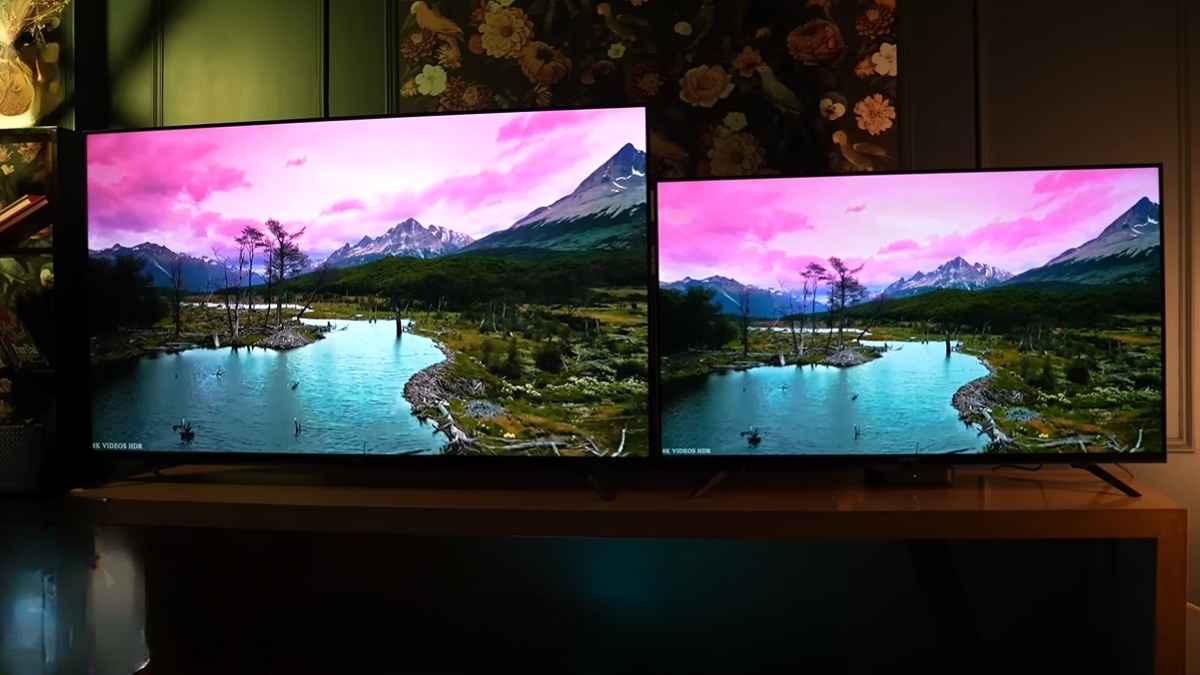In the Indian market, QLED TVs from big brands like Samsung, LG or Sony are rarely available for less than ₹60,000–70,000. Over the years, buyers looking for premium picture quality with QLED technology have had to spend a hefty sum. Now a new brand, Lumia (or Lumio), entered the scene with a bold claim—offering a true QLED experience at nearly half the price their Lumia Seven QLED TV It is available in 43-inch, 50-inch, and 55-inch models, priced around ₹30,000-₹45,000, making it one of the most affordable QLED TVs in India.
But does this budget-friendly QLED really live up to the hype? Let’s break it down.
Design and build quality
The Lumia 7 QLED TV makes a strong first impression with it Thin bezel and a modern, premium look. The bezels are almost invisible from a distance, giving it a sleek look. Lumia used one Metal + plastic composite body, which feels sturdy, while the stands inside the box are plastic. Wall mounting is optional and chargeable, although installation is free.
Remote, called Lumia “Minion Remote”, deserves a mention. It is compact, fresh in design, and comes with four hotkeys with a name TLDR, a shortcut that instantly opens sports, music, and YouTube-powered content It’s a fun little touch that adds uniqueness to the brand.
Display and picture quality
Unlike most budget QLED TVs that use VA panels, the Lumia has taken a different route. D The 43-inch and 55-inch variants use an IPS QLED panel, when The 50-inch version comes with a VA panel.
- Brightness: 43 inch model Billy 333 nits sustained brightness (briefly peaks at 400 nits). The 55-inch version measures approx 310 nits sustained (peak around 375 nits) These numbers are fair for the price and more than adequate for HDR playback in a moderately lit room.
- Contrast: IPS panels aren’t known for deep blacks, and the Lumia is no exception, with a contrast ratio of around 960:1 to 1050:1. However, turn on the TV Dynamic contrast mode Significantly improves perceived blacks, making dark scenes look much better than expected.
- Color performance: Lumia claims 114% DCI-P3 gamut, but independent testing has shown that 92% DCI-P3 and 100% sRGB coverage. While not as wide as claimed, it’s still impressive for a budget QLED. Some oversaturation is visible in reds and blues, but overall picture quality remains vibrant and pleasant.
Smooth with motion handling MEMC (Motion Estimation, Motion Compensation), which, despite being software-based, works well for quality panels. No noticeable motion blur, banding or blooming in everyday use.
HDR performance
TV supports HDR10, HLG, and Dolby Vision, covers all major HDR formats except HDR10+ HDR content looks vibrant and dynamic on platforms like Netflix and Prime Video. Bright highlights, though not as punchy as high-end TVs, are decent, and dark scenes retain detail thanks to good quality LEDs behind the panel.
Software and performance
Lumia 7 is running Google TV OS 11. Although version 12 is already available, the OS runs smoothly here and most users won’t feel the difference. The UI is responsive and intuitive, offering familiar carousels with OTT app suggestions.
The real star is her 3GB RAM, paired with DDR4 memory (as claimed by Lumia). In practice, it makes navigation snappy, loading apps seamlessly and switching between menus feels fluid. Many Android and Google TVs with 2GB of RAM suffer from stuttering, but the Lumia avoids this problem entirely.
Connectivity and Gaming
Lumia stands out in connectivity. It includes:
- 3x HDMI 2.1 ports (including eARC and ALLM support)
- 3x USB ports (2x USB 2.0 + 1x USB 3.0)
- Optical port, dual-band WiFi, Bluetooth 5.0
This is notable for a budget TV, as most competitors only offer HDMI 2.0.
For gaming, the TV offers ALLM (Auto Low Latency Mode) with input lag between 14-18 ms. At 60Hz, it’s not made for hardcore gamers, and has no VRR (variable refresh rate). However, for Casual gaming or HDR gaming on consoles like the PS5, it performs well.
Audio quality
This is one of Lumia’s boldest moves 30W speaker system, integrated Two full-range drivers and two tweeters. While most brands add a small subwoofer, the Lumia focuses on clarity, especially on dialogue and vocals. Dolby Atmos support enhances the overall experience. If you want deep bass, you’ll still need a soundbar, but for everyday TV viewing, the Lumia’s audio is refreshingly clear.
Upscaling and channels
HD content is well developed, looks sharp and enjoyable. However, standard-definition (SD) channels show noticeable pixelation on the 4K screen, which is typical of most 4K TVs in this range. Unlike some established brands, Lumia doesn’t offer free live TV channels, instead focusing on hardware quality.
Verdict – Should you buy the Lumia 7 QLED TV?
D Lumia Seven QLED TV It’s a bold entry into the budget QLED space, and it succeeds in many ways. Picture quality is vibrant, HDR support is strong, OS runs smoothly with 3GB of RAM and connectivity options are top notch. Add this 2 year comprehensive warranty, and Lumia is clearly trying to build trust as a new brand.
👍 Professional
- True QLED panel with good brightness and dynamic contrast
- Wide color coverage (92% DCI-P3, 100% sRGB)
- Dolby Vision + HDR10 + HLG support
- 3GB RAM ensures smooth OS performance
- HDMI 2.1 port with ALLM, eARC
- Crisp audio with tweeter and Dolby Atmos
👎 Difficulty
- Marketing exaggeration (114% DCI-P3 claims are incorrect)
- Not suitable for hardcore gaming (60Hz only, no VRR)
- OS version is a bit old (Google TV 11)
- SD upscaling could be better
If you’re looking for an affordable QLED TV in the ₹30,000–45,000 range, the Lumia Seven QLED offers exceptional value. It won’t match the deep blacks and overall refinement of premium QLEDs from Samsung or LG, but at half the price, it delivers. Impressive performance, sleek design, and great features.

